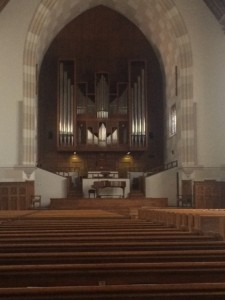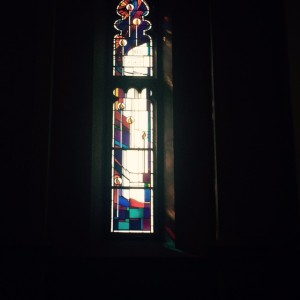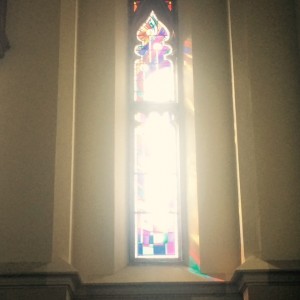Paintings
 There are six points of rainbow prisms on the right hand pews. Normally, there are just two and they are isolated to the back section. Today, there are four stretching diagonally across the front section on the right side. The angle at which the light is being reflected from the right windows is significantly more severe than it has been previously. The back small window is casting reflections all along the wall adjacent to it. The light looks like brush strokes, lightly covering the plaster but not changing it. I have no idea why that’s happening- perhaps the stained glass isn’t a perfectly flat surface
There are six points of rainbow prisms on the right hand pews. Normally, there are just two and they are isolated to the back section. Today, there are four stretching diagonally across the front section on the right side. The angle at which the light is being reflected from the right windows is significantly more severe than it has been previously. The back small window is casting reflections all along the wall adjacent to it. The light looks like brush strokes, lightly covering the plaster but not changing it. I have no idea why that’s happening- perhaps the stained glass isn’t a perfectly flat surface  and the light is coming through it at different angles.
and the light is coming through it at different angles.
You have to really look to see the color on the left side. It’s noticeable only if you intend to find it or know that it should be there. In contrast to the brush strokes on the other side, it looks instead like it’s just a bluer or purpler stone.
I don’t know if i’ve ever noted how WHITE the tops if the pews get in the more direct sun. The intensity of the light overpowers the brown leaving it white. Somebody left the  artificial lights by the organ on. They, interestingly enough, draw the eye away from the organ, holding the focus where the choir would potentially stand.
artificial lights by the organ on. They, interestingly enough, draw the eye away from the organ, holding the focus where the choir would potentially stand.
The brush strokes keep fading and brightening. Even at the brightest intensity, they remain brushstrokes. The color is in a wholly separate world from the rest of the space. Going one window forward, the light directly to the side looks more even and filled in – I would guess because the sunlight from outside is more direct.